A glowing legacy
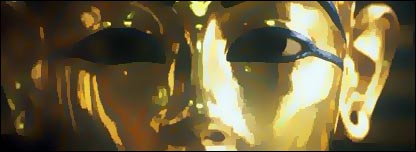
By Jonathan Fildes
BBC News


The O2 (formerly the Millennium Dome) on the banks of the River Thames in London is hosting an exhibition displaying pharoah Tutankhamun's treasures. It is the first time the treasures of Tutankhamun have been displayed in Britain since 1972 - and, like then, the exhibition is proving immensely popular. Tutankhamun's mummified body and his treasures were discovered by the British in 1922 - Howard Carter and several of his men supposedly dying of a curse.
------------------------------------
After 35 years, Tutankhamun is returning to London. Yet the influence of the original 1972 exhibition has never gone away - it was the first blockbuster exhibition, spawning queues around the block and tea-towel memorabilia.
"Been there, bought the T-shirt" was the sort of gleeful boast you could expect from a child who had just visited a theme park. Today, it could be someone returning from an art exhibition.
Whether it's Pompeii AD79 at the Royal Academy, Edward Hopper at the Tate Modern or Picasso at the National Gallery, many art and artefact exhibitions now come with blockbuster status, drawing hundreds of thousands of visitors to gawp at their unique collections, amassed for one time only.
But none of them hold a flame to the daddy of them all; the original epic show: The Treasures of Tutankhamen.
 TREASURES OF TUTANKHAMUN
TREASURES OF TUTANKHAMUN
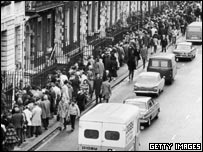
Travelling exhibition ran from 1972 - 1979
First shown at London's British Museum
Admission was 50p
There were long queues (above); some waited for eight hours

From its opening in spring 1972 at the British Museum, this treasure trove tribute to the 3,000 year old boy king attracted 1.7 million visitors.
Even the Royal Academy of Arts' Monet in the Twentieth Century show in 1999, which stayed open through the night on its final weekend, only chalked up 700,000 visitors.
But such shows would have been unthinkable before King Tut's brief visit to London in 1972.
The Treasures of Tutankhamen was the first "blockbuster" exhibition. "It raised the game," says Sir Christopher Frayling, rector of London's Royal College of Art.
It defined the term and set the bar so high that every exhibition since has been measured against it.
"It was a significant moment - it's something to cite to all up and coming curators," adds Dr Beverley Butler an expert in museum studies at University College London. "It has its place in museology and in museum history."
The show brought together the very best of the artefacts uncovered by British archaeologist Howard Carter who unearthed the Tutankhamun tomb in 1922, and brought them to Britain for the first time.
"It was a dizzying array of material and all of the greatest hits were there," Sir Christopher recalls.
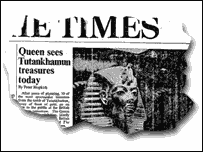 Visited by the Queen, in March 1972
Visited by the Queen, in March 1972
Central to it was the famous gold death mask, an artefact that will be conspicuously absent from the new Tutankhamun exhibition at the O2, formerly known as the Dome, later in the year.
"I just stood there and literally trembled - it was an incredible sensation," said one of the many that queued for up to eight hours for a face-to-face with the boy king in 1972.
The relics, including a towering statue that had guarded the entrance to his tomb, were displayed in hushed, darkened rooms, designed to echo the tomb in which they had been found.
"All of these gold and jewelled treasures jumped out at you," says Professor Rosalie David, an Egyptologist at the University of Manchester. "It was just beautifully displayed."
The design, which showed off the glittering artefacts in the order they had been discovered became a yardstick for museums and art galleries, which until then had mostly made do with dusty glass cases and hand-written labels.
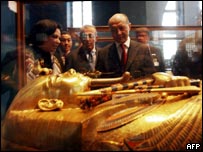 Visiting the exhibition in Cairo - the mask will not be on show in London
Visiting the exhibition in Cairo - the mask will not be on show in London
The revelations continued... in the museum shop, where Sir Christopher remembers the "surprise" of "the magazines, booklets, facsimiles and souvenirs that went with it".
A Time magazine article from 1972 reported: "The English, normally phlegmatic about art, greeted the event with ecstasies of Tutankhamenophilia. Tut appeared on posters, postcards, carrier bags and 56 million commemorative stamps."
Such was the public's taste for taking home a bit of King Tut, the museum sold out of replica jewellery on the first day, and ever since museum managers have ensured that departing visitors should always be directed through the shop before reaching the exit.
No modern blockbuster is complete without official mugs, keyrings, prints, tea-towels and, of course, T-shirts. According to Sir Christopher, the souvenir business was a by-product of the deal that allowed the treasures to go on tour.
"The Egyptian government struck a hard bargain, which was that 'you can have it but we want to share the profits'."
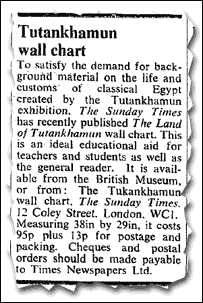 Immortality assured... King Tut started the craze for newspaper wall-charts
Immortality assured... King Tut started the craze for newspaper wall-charts
But deals stretched far beyond just souvenirs - with the exhibition doubling up as a sort of international diplomacy roadshow.
After all, the world tour had been negotiated by the then secretary of state for the US Henry Kissinger, as part of a deal in the Middle East, says Sir Christopher.
The deal has spawned several copycat agreements to ensure the success of other big exhibitions.
But perhaps the exhibition's most enduring legacy is with the 1.7 million people who visited the British Museum in 1972 and the millions more who saw the artefacts elsewhere around the globe.
"I think it was a real turning point. Until then Egyptology was a specialist field, but this really opened it up to the whole world," says Prof David.
The blockbuster, the cultural equivalent of dropping the TV schedules to show the Champion's League final, guaranteed huge audiences from all walks of life. "Everybody knew about it and talked about it. It revived the kind of interest when the tomb was actually discovered."
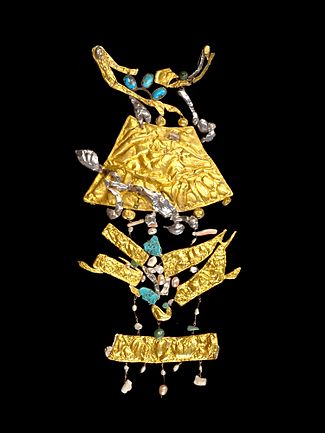
The 3000 year old pharaoh's magnificent gold and blue death mask has not been taken to London for the exhibition.
news.bbc.co.uk

By Jonathan Fildes
BBC News


The O2 (formerly the Millennium Dome) on the banks of the River Thames in London is hosting an exhibition displaying pharoah Tutankhamun's treasures. It is the first time the treasures of Tutankhamun have been displayed in Britain since 1972 - and, like then, the exhibition is proving immensely popular. Tutankhamun's mummified body and his treasures were discovered by the British in 1922 - Howard Carter and several of his men supposedly dying of a curse.
------------------------------------
After 35 years, Tutankhamun is returning to London. Yet the influence of the original 1972 exhibition has never gone away - it was the first blockbuster exhibition, spawning queues around the block and tea-towel memorabilia.
"Been there, bought the T-shirt" was the sort of gleeful boast you could expect from a child who had just visited a theme park. Today, it could be someone returning from an art exhibition.
Whether it's Pompeii AD79 at the Royal Academy, Edward Hopper at the Tate Modern or Picasso at the National Gallery, many art and artefact exhibitions now come with blockbuster status, drawing hundreds of thousands of visitors to gawp at their unique collections, amassed for one time only.
But none of them hold a flame to the daddy of them all; the original epic show: The Treasures of Tutankhamen.


Travelling exhibition ran from 1972 - 1979
First shown at London's British Museum
Admission was 50p
There were long queues (above); some waited for eight hours

From its opening in spring 1972 at the British Museum, this treasure trove tribute to the 3,000 year old boy king attracted 1.7 million visitors.
Even the Royal Academy of Arts' Monet in the Twentieth Century show in 1999, which stayed open through the night on its final weekend, only chalked up 700,000 visitors.
But such shows would have been unthinkable before King Tut's brief visit to London in 1972.
The Treasures of Tutankhamen was the first "blockbuster" exhibition. "It raised the game," says Sir Christopher Frayling, rector of London's Royal College of Art.
It defined the term and set the bar so high that every exhibition since has been measured against it.
"It was a significant moment - it's something to cite to all up and coming curators," adds Dr Beverley Butler an expert in museum studies at University College London. "It has its place in museology and in museum history."
The show brought together the very best of the artefacts uncovered by British archaeologist Howard Carter who unearthed the Tutankhamun tomb in 1922, and brought them to Britain for the first time.
"It was a dizzying array of material and all of the greatest hits were there," Sir Christopher recalls.

Central to it was the famous gold death mask, an artefact that will be conspicuously absent from the new Tutankhamun exhibition at the O2, formerly known as the Dome, later in the year.
"I just stood there and literally trembled - it was an incredible sensation," said one of the many that queued for up to eight hours for a face-to-face with the boy king in 1972.
The relics, including a towering statue that had guarded the entrance to his tomb, were displayed in hushed, darkened rooms, designed to echo the tomb in which they had been found.
"All of these gold and jewelled treasures jumped out at you," says Professor Rosalie David, an Egyptologist at the University of Manchester. "It was just beautifully displayed."
The design, which showed off the glittering artefacts in the order they had been discovered became a yardstick for museums and art galleries, which until then had mostly made do with dusty glass cases and hand-written labels.

The revelations continued... in the museum shop, where Sir Christopher remembers the "surprise" of "the magazines, booklets, facsimiles and souvenirs that went with it".
A Time magazine article from 1972 reported: "The English, normally phlegmatic about art, greeted the event with ecstasies of Tutankhamenophilia. Tut appeared on posters, postcards, carrier bags and 56 million commemorative stamps."
Such was the public's taste for taking home a bit of King Tut, the museum sold out of replica jewellery on the first day, and ever since museum managers have ensured that departing visitors should always be directed through the shop before reaching the exit.
No modern blockbuster is complete without official mugs, keyrings, prints, tea-towels and, of course, T-shirts. According to Sir Christopher, the souvenir business was a by-product of the deal that allowed the treasures to go on tour.
"The Egyptian government struck a hard bargain, which was that 'you can have it but we want to share the profits'."

But deals stretched far beyond just souvenirs - with the exhibition doubling up as a sort of international diplomacy roadshow.
After all, the world tour had been negotiated by the then secretary of state for the US Henry Kissinger, as part of a deal in the Middle East, says Sir Christopher.
The deal has spawned several copycat agreements to ensure the success of other big exhibitions.
But perhaps the exhibition's most enduring legacy is with the 1.7 million people who visited the British Museum in 1972 and the millions more who saw the artefacts elsewhere around the globe.
"I think it was a real turning point. Until then Egyptology was a specialist field, but this really opened it up to the whole world," says Prof David.
The blockbuster, the cultural equivalent of dropping the TV schedules to show the Champion's League final, guaranteed huge audiences from all walks of life. "Everybody knew about it and talked about it. It revived the kind of interest when the tomb was actually discovered."

The 3000 year old pharaoh's magnificent gold and blue death mask has not been taken to London for the exhibition.
news.bbc.co.uk
Last edited: